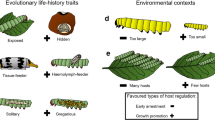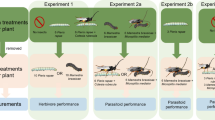Abstract
Plant secondary chemicals can alter herbivore suitability for parasitoids by weakening or stunting the host, delaying its development, or when larval parasitoids encounter ingested phytotoxins in the body of their host. Experiments with different parasitoids that exploit the same host species feeding on the same plant may provide insight about how parasitoid life history affects the strength of such interactions. The encyrtid wasp Copidosoma bakeri, a slow-developing polyembryonic egg-larval parasitoid, and the tachinid fly Linnaemya comta, a fast-developing solitary species, both parasitize Agrotis ipsilon, a generalist noctuid. We tested the hypothesis that of the two parasitoid species, the encyrtid, because of its more prolonged developmental association with the host, would suffer greater fitness costs when A. ipsilon feeds on perennial ryegrass containing an alkaloid-producing fungal endophyte. Indeed, fewer parasitized cutworms yielded C. bakeri broods, and those host mummies were smaller, formed more slowly, and contained fewer adults when the hosts fed on endophytic as opposed to endophyte-free grass. In contrast, L. comta fitness parameters were similar regardless of the type of grass upon which their host fed. Our results highlight that the outcome of endophyte-mediated tritrophic interactions may differ for different parasitoid species. Implications for integrating the use of endophytic grasses and biological control are discussed.



Similar content being viewed by others
References
Analytical Software (2008) Statistix version 8, user’s manual. Analytical Software, Tallahassee
Arnaud PH Jr (1978) A host-parasite catalog of North American Tachinidae (Diptera). Misc Pub, No. 1319, SEA, USDA, 860 pp
Bacon CW, Lyons PC, Porter JK, Robbins JD (1986) Ergot toxicity from endophyte-infected grasses: a review. Agron J 78:106–116
Baehrecke EH, Strand MR (1990) Embryonic morphology and growth of the polyembryonic parasitoid Copidosoma floridanum (Ashmead) (Hymenoptera: Encyrtidae). Int J Insect Morphol Embryol 19:165–175
Barbosa P, Saunders J (1985) Plant allelochemicals: linkages between herbivores and their natural enemies. In: Cooper-Driver GA, Swain T, Conn EE (eds) Chemically mediated interactions between plants and other organisms. Plenum, New York, pp 107–138
Barbosa P, Gross P, Kemper J (1991) Influence of plant allelochemicals on the tobacco hornworm and its parasitoid, Cotesia congregate. Ecology 72:1567–1575
Barker GM, Addison PJ (1996) Influence of clavicipitaceous endophyte infection in ryegrass on development of the parasitoid Microctonus hyperodae Loan (Hymenoptera: Braconidae) in Listronotus bonariensis (Kuschel) (Coleoptera: Curculionidae). Biol Control 7:281–287
Barker GM, Addison PJ (1997) Clavicipitaceous endophytic infection in ryegrass influences attack rate of the parasitoid Microctonus hyperodae (Hymenoptera: Braconidae, Euphorinae) in Listronotus bonariensis (Coleoptera: Curculionidae). Environ Entomol 26:416–420
Beach RM, Todd LW (1986) Foliage consumption and larval development of parasitized and unparasitized soybean looper, Pseudoplusia includes [Lep: Noctuidae], reared on resistant soybean genotype and effects on an associated parasitoid, Copidosoma truncatellum [Hym: Encyrtidae]. Entomophaga 31:237–242
Bixby-Brosi AJ, Potter DA (2010) Evaluating a naturally occurring baculovirus for extended biological control of the black cutworm (Lepidoptera: Noctuidae) in golf course habitats. J Econ Entomol 103:1555–1563
Blanco CA, Portilla M, Abel CA, Winters H, Ford R, Streett D (2009) Soybean flour and wheat germ proportions in artificial diet and their effect on the growth rates of the tobacco budworm, Heliothis virescens. J Insect Sci 9:59
Breen JP (1994) Acremonium endophyte interactions with enhanced plant resistance to insects. Ann Rev Entomol 39:401–423
Bultman TL, Borowicz KL, Schneble RM, Coudron TA, Bush LP (1997) Effect of a fungal endophyte on the growth and survival of two euplectrus parasitoids. Oikos 78:170–176
Bush LP, Wilkinson HH, Schardl CL (1997) Bioprotective alkaloids of grass-fungal endophyte symbioses. Plant Physiol 114:1–7
Byers JR, Yu DS, Jones W (1993) Parasitism of the army cutworm, Euxoa auxiliaris (GRT) (Lepidoptera: Noctuidae), by Copidosoma bakeri (Howard) (Hymenoptera: Encyrtidae) and effect on crop damage. Can Entomol 125:329–335
Campbell BC, Duffey SS (1979) Tomatine and parasitic wasps: potential incompatibility of plant antibiosis with biological control. Science 205:700–702
Clay K (1991) Fungal endophytes, grasses and herbivores. In: Barbosa P, Krischik VA, Jones CG (eds) Microbial mediation of plant-herbivore interactions. Wiley, New York, pp 199–252
Clay K (1997) Fungal endophytes, herbivores and the structure of grassland communities. In: Gange AC, Brown VK (eds) Multitrophic interactions in terrestrial systems. Cambridge University Press, Cambridge, pp 151–170
Cossentine JE, Lewis LC (1986) Potential of Bonnetia comta (Diptera: Tachinidae) in combination with a nuclear polyhedrosis virus to control Agrotis ipsilon (Lepidoptera: Noctuidae) larvae on corn. Environ Entomol 15:360–364
Crumb SE (1956) The larvae of the Phalaenidae. USDA Tech Bull 1135:356
De Moraes CM, Lewis WJ, Pare PW, Alborn HT, Tumlinson JH (1998) Herbivore-infested plants selectively attract parasitoids. Nature 393:570–573
Duffey SS, Bloem KA, Campbell BC (1986) Consequences of sequestration of plant natural products in plant-insect-parasitoid interactions. In: Boethel DJ, Eikenbary RD (eds) Interactions of plant resistance and parasitoids and predators of insects. Ellis Horwood Limited, UK, pp 31–60
Farrar RR Jr, Kennedy GG (1993) Field cage performance of two parasitoids of the tomato fruitworm on insect resistant and susceptible tomato lines. Entomol Exp Appl 67:73–78
Farrar RR Jr, Kennedy GG, Kashyap RK (1992) Influence of life history differences of two tachinid parasitoids of Helicoverpa zea (Boddie) (Lepidoptera: Noctuidae) on their interactions with glandular trichome/methyl Ketone-based insect resistance in tomato. J Chem Ecol 18:499–515
Fukushima J, Kainoh Y, Honda H, Takabayashi J (2002) Learning of herbivore-induced and nonspecific plant volatiles by a parasitoid, Cotesia kariyai. J Chem Ecol 28:579–586
Gauld ID, Gaston KJ (1994) The taste of enemy-free space: parasitoids and nasty hosts. In: Hawkins BA, Sheehan W (eds) Parasitoids community ecology. Oxford University Press, Oxford, pp 279–299
Godfray HCJ (1994) Parasitoids: behavior and evolutionary ecology. Princeton University Press, Princeton
Heil M (2008) Indirect defense via tritrophic interactions. New Phytol 178:41–61
Ivanova-Kasas OM (1972) Polyembryony in insects. In: Counce SJ, Waddington CH (eds) Developmental systems, vol 2. Insects. Academic Press, New York, pp 243–271
Kennedy GG (2003) Tomato, pests, parasitoids, and predators: tritrophic interactions involving the genus Lycopersicon. Annu. Rev. Entomol 48:51–72
Kunkel BA, Grewal PS (2003) Endophyte infection in perennial ryegrass reduces the susceptibility of black cutworm to entomopathogenic nematodes. Entomol Exp Appl 107:95–104
Lampert EC, Bowers MD (2010) Host plant species affects the quality of the generalist Trichoplusia ni as a host for the polyembryonic parasitoid Copidosoma floridanum. Entomol Exp Appl 134:287–295
Lampert EC, Zangerl AR, Berenbaum MR, Ode PJ (2011) Generalist and specialist host–parasitoid associations respond differently to wild parsnip (Pastinaca sativa) defensive chemistry. Ecol Entomol 36:52–61
Levine E, Clement SL (1981) Effect of Parasitism by Bonnetia comta on larvae of Agrotis ipsilon. J Kansas Ent Soc 54:219–222
Mackauer M, Sequeira R (1993) Patterns of development in insect parasites. In: Beckage NE et al (eds) Parasites and pathogens of insects, vol 1 parasites. Academic Press, New york, pp 1–23
Nordlund DA, Lewis WJ, Altieri MA (1988) Influences of plant-produced allelochemicals on the host-prey selection behavior of entomophagous insects. In: Barbosa P, le Tourneau DK (eds) Novel aspects of insect-plant interactions. Wiley, New York, pp 65–90
Ode PJ, Strand MR (1995) Progeny and sex allocation decisions of the polyembryonic wasp Copidosoma floridanum. J Animal Ecol 64:213–224
O’Hara JE (2008) Tachinid flies (Diptera: Tachinidae). In: Capinera JL (ed) Encyclopedia of entomology vol 4, S–Z, 2nd edn. Springer, Dordrecht, pp 3675–3686
O’Hara JE, Wood DM (2004) Catalogue of the Tachinidae (Diptera) of America north of Mexico. Mem Entomol Int 18:410
Omacini M, Chaneton EJ, Ghersa CM, Muller CB (2001) Symbiotic fungal endophytes control insect host–parasite interaction webs. Nature 409:78–81
Orr DB, Boethel DJ (1985) Comparative development of Copidosoma truncatellum (Hymenoptera: Encyrtidae) and its host, Pseudoplusia includes (Lepidoptera: Noctuidae), on resistant and susceptible soybean genotypes. Environ Entomol 14:612–616
Potter DA (1998) Destructive turfgrass insects: biology, diagnosis and control. Wiley, New York
Potter DA, Stokes JT, Redmond CT, Schardl CL, Panaccione DG (2008) Contribution of ergot alkaloids to suppression of a grass-feeding caterpillar assessed with gene knockout endophytes in perennial ryegrass. Entomol Exp Appl 126:138–147
Price PW (1986) Ecological aspects of host plant resistance and biological control: interactions among three trophic levels. In: Boethel DJ, Eikenbary RD (eds) Interactions of plant resistance and parasitoids and predators of insects. Horwood, UK, pp 11–30
Price PW, Bouton CE, Gross P, McPheron BA, Thompson JN, Weis AE (1980) Interactions among three trophic levels–influence of plants on interactions between insect herbivores and natural enemies. Annu Rev Ecol Syst 11:41–65
Reitz SR, Trumble JT (1996) Tritrophic interactions among linear furanocoumarins, the herbivore Trichoplusia ni (Lepidoptera: Noctuidae), and the polyembryonic parasitoid Copidisoma floridanum (Hymenoptera: Encyrtidae). Environ Entomol 25:1391–1397
Richmond DS, Niemczyk HD, Shetlar DJ (2000) Overseeding endophytic perennial ryegrass into stands of Kentucky bluegrass to manage bluegrass billbug (Coleoptera: Curculionidae). J Econ Entomol 93:1662–1668
Rubink WL, Clement SL (1982) Reproductive biology of Bonnetia comta (Fallen) (Diptera: Tachinidae), a parasitoid of the black cutworm, Agrotis ipsilon Hufnagel (Lepidoptera: Noctuidae). Environ Entomol 11:981–985
Saeki Y, Crowley PH, Fox CW, Potter DA (2009) A sex-specific tradeoff in clonal broods. Oikos 188:1552–1560
Schaaf AC (1972) The parasitoid complex of Euxoa ochrogaster (Guenee) (Lepidoptera: Noctuidae). Quaest Entomol 8:81–120
Schardl CL, Leuchtmann A, Spiering MJ (2004) Symbioses of grasses with seedborne fungal endophytes. Annu Rev Plant Biol 55:315–340
Schardl CL, Panaccione DG, Tudzynski P (2006) Ergot alkaloids–biology and molecular biology. In: Corell GA (ed) The alkaloids: chemistry and biology. Elsevier, UK, pp 45–86
Senthamizhselvan M, Muthukrishnan J (1989) Effect of parasitization by a gregarious and a solitary parasitoid on food consumption and utilization by Porthesia scintillans Walker (Lepidoptera: Lymantriidae) and Spodoptera exigua Hubner (Lepidoptera: Noctuidae). Parasitol Res 76:166–170
Shelby RA, Dalrymple LWT (1987) Incidence and distribution of the tall fescue endophyte in the United States. Plant Dis 71:783–786
Siegel MR, Bush LP (1996) Defensive chemicals in grass-fungal endophyte associations. In: Romeo JT, Saunders JA, Barbosa P (eds) Phytochemical diversity and redundancy in ecological interactions, recent advances in phytochemistry, vol 30. Springer, Boston, pp 81–120
Siegel MR, Latch GCM, Johnson MC (1987) Fungal endophytes of grasses. Annu Rev Phytopathol 25:293–315
Singer MS, Mace KC, Bernays EA (2009) Self-medication as adaptive plasticity: increased ingestion of plant toxins by parasitized caterpillars. PLoS ONE 4:e4796
Slansky F Jr (1986) Nutritional ecology of endoparasitic insects and their hosts: an overview. J Insect Physiol 32:255–261
Strand MR (1989a) Development of the polyembryonic parasitoid Copidosoma floridanum in Trichoplusia ni. Entomol. Exp. Appl. 50:37–46
Strand MR (1989b) Oviposition behavior and progeny allocation of the polyembryonic wasp Copidosoma floridanum (Hymenoptera: Encyrtidae). J Insect Behav 2:355–369
Thorpe KW, Barbosa P (1986) Effects of consumption of high and low nicotine tobacco by Manduca sexta (Lepidoptera: Sphingidae) on survival of gregarious endoparasitoid Cotesia congregate (Hymenoptera: Braconidae). J Chem Ecol 12:1329–1337
Turlings TCJ, Benrey B (1998) Effects of plant metabolites on the behavior and development of parasitic wasps. Ecoscience 5:321–333
Turlings TCJ, Wäckers FL, Vet LEM, Lewis WJ, Tumlinson JH (1992) Learning of host-location cues by hymenopterous parasitoids. In: Lewis AC, Papaj DR (eds) Insect learning: ecological and evolutionary perspectives. Chapman and Hall, New York, pp 51–78
van der Meijden E (1980) Can hosts escape from their parasitoids? The effects of food shortage on the braconid parasitoid Apanteles popularis and its host Tyria jacobaeae. Neth J Zool 30:382–392
Williamson RC, Potter DA (1997) Turfgrass species and endophyte effects on survival, development, and feeding preference of black cutworms. J Econ Entomol 90:1290–1299
Wood DM (1987) Tachinidae. In: McAlpine JF (ed) Manual of Nearctic Diptera volume 2. Research branch, Agriculture Canada. Monograph No. 28. pp 1193–1269
Acknowledgments
We thank G. Brosi and E. Dobbs for technical assistance, M. Strand and M. Smith (University of Georgia) for providing C. bakeri to start colonies, R. Bessin for statistical guidance, and J. White and J. Peterson for critically reviewing an earlier draft of this article. This research was partially supported by grants from the United States Golf Association Turfgrass and Environmental Research Program, and from the O. J. Noer Research Foundation. This is paper is 11-08-043 of the Kentucky Agricultural Experiment Station.
Author information
Authors and Affiliations
Corresponding author
Additional information
Handling editor: Jonathan Lundgren.
Rights and permissions
About this article
Cite this article
Bixby-Brosi, A.J., Potter, D.A. Endophyte-mediated tritrophic interactions between a grass-feeding caterpillar and two parasitoid species with different life histories. Arthropod-Plant Interactions 6, 27–34 (2012). https://doi.org/10.1007/s11829-011-9163-2
Received:
Accepted:
Published:
Issue Date:
DOI: https://doi.org/10.1007/s11829-011-9163-2




